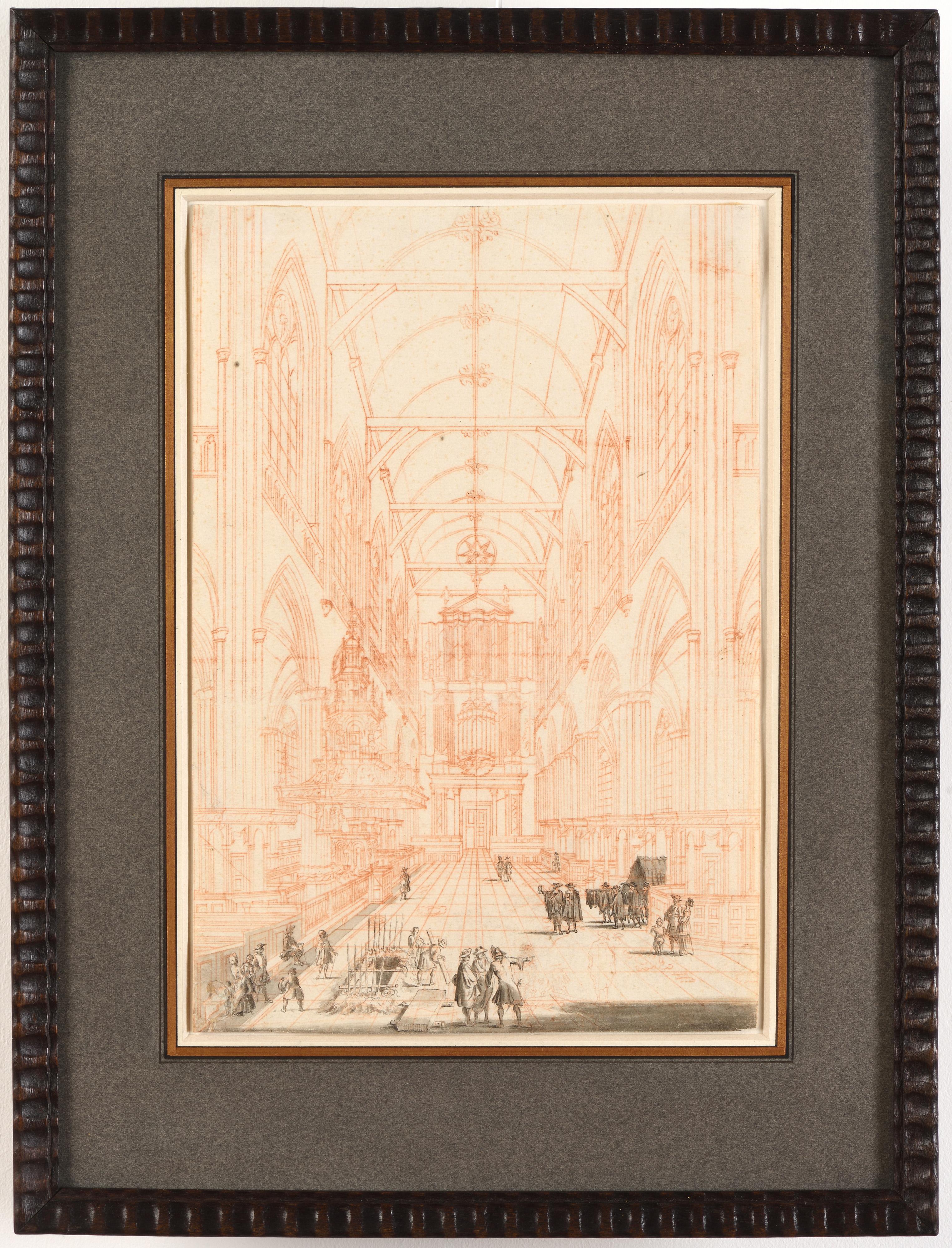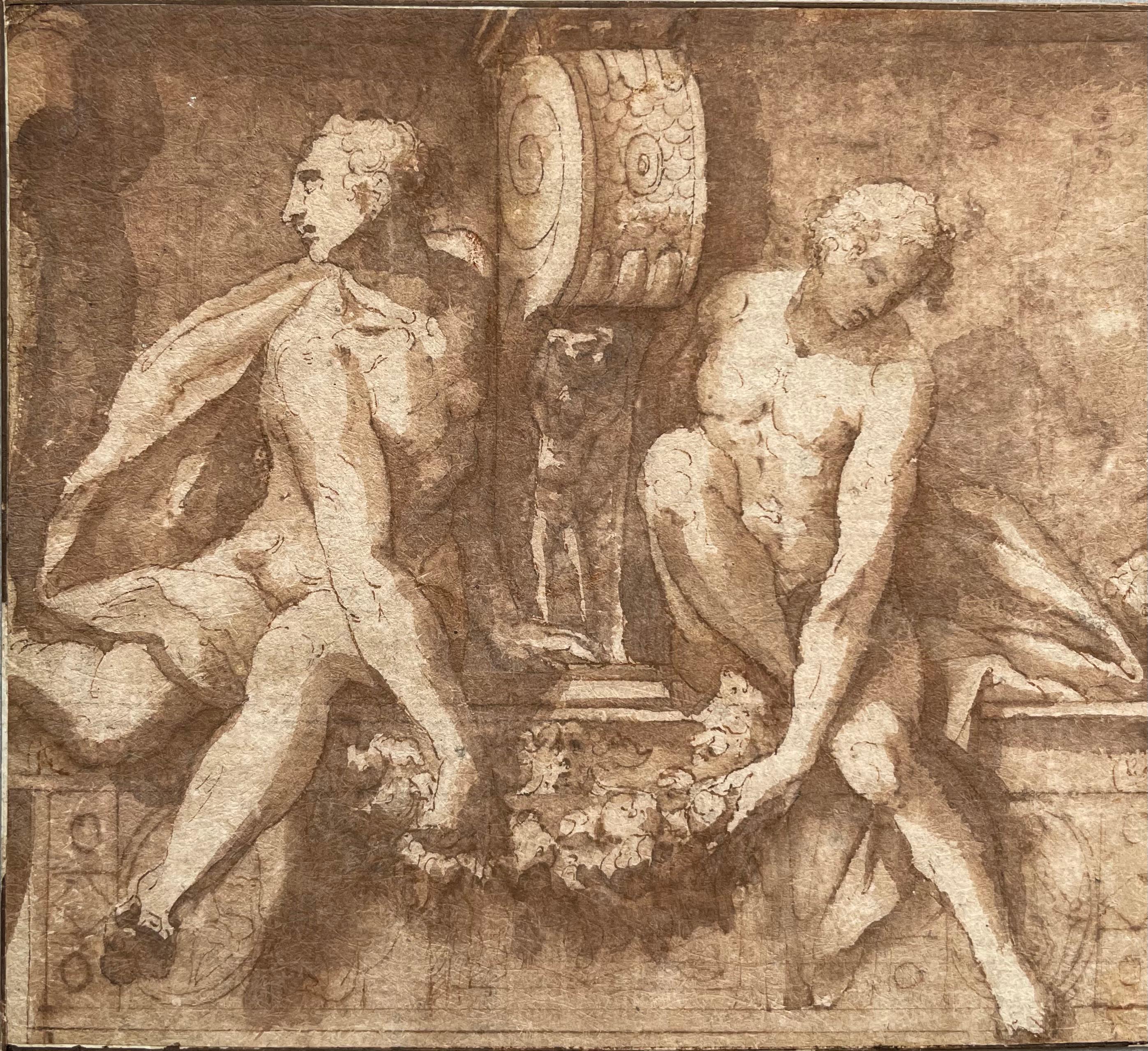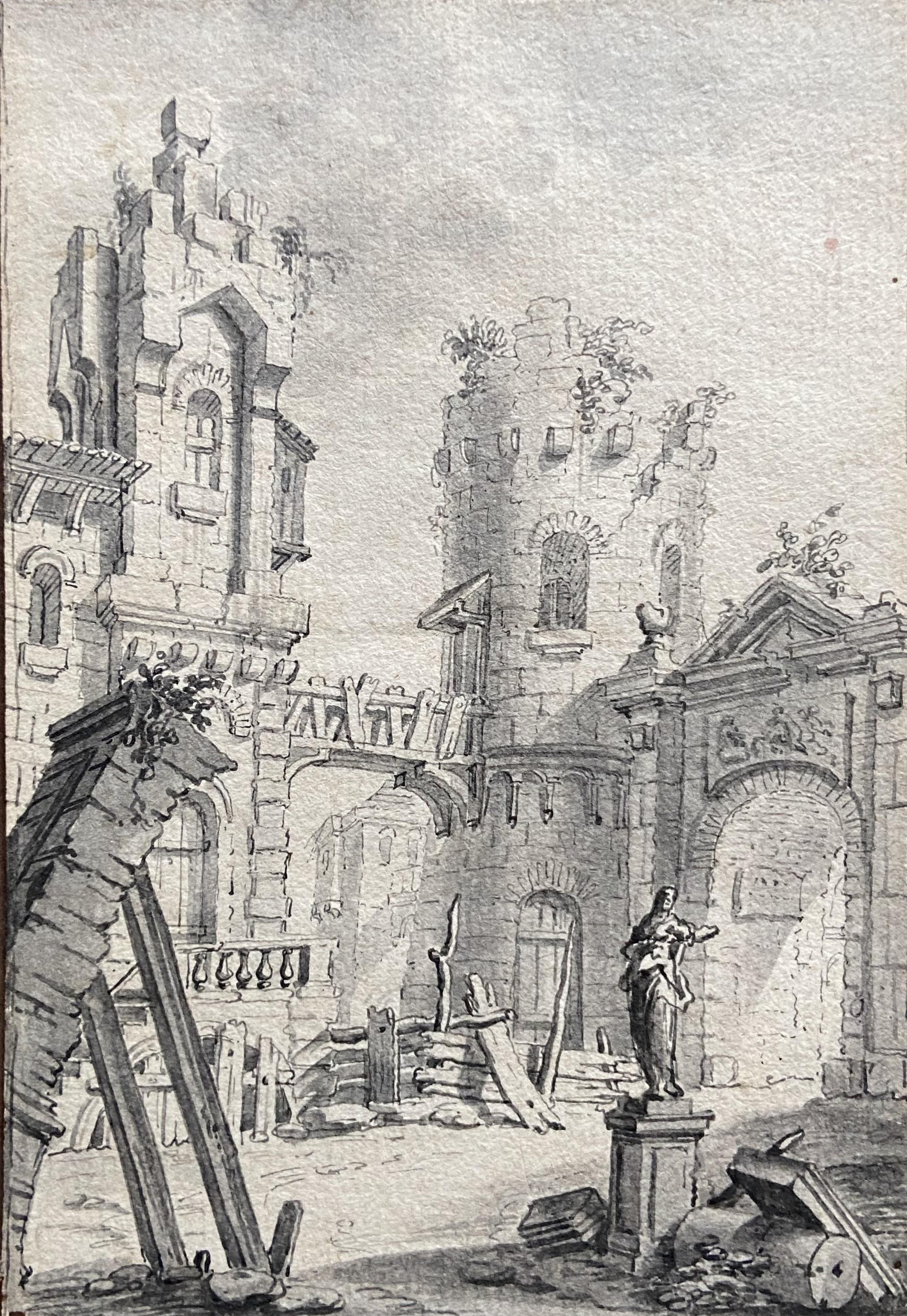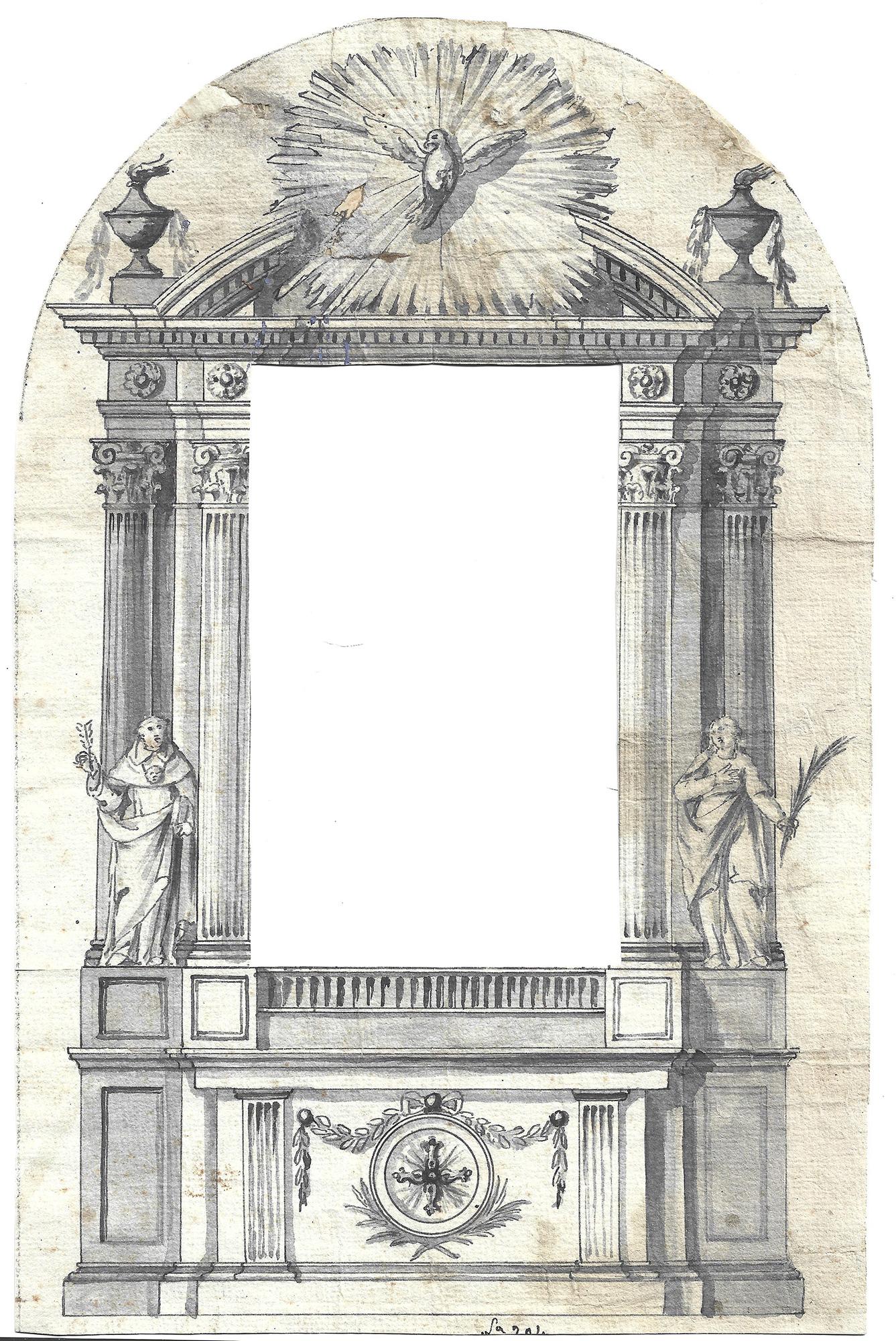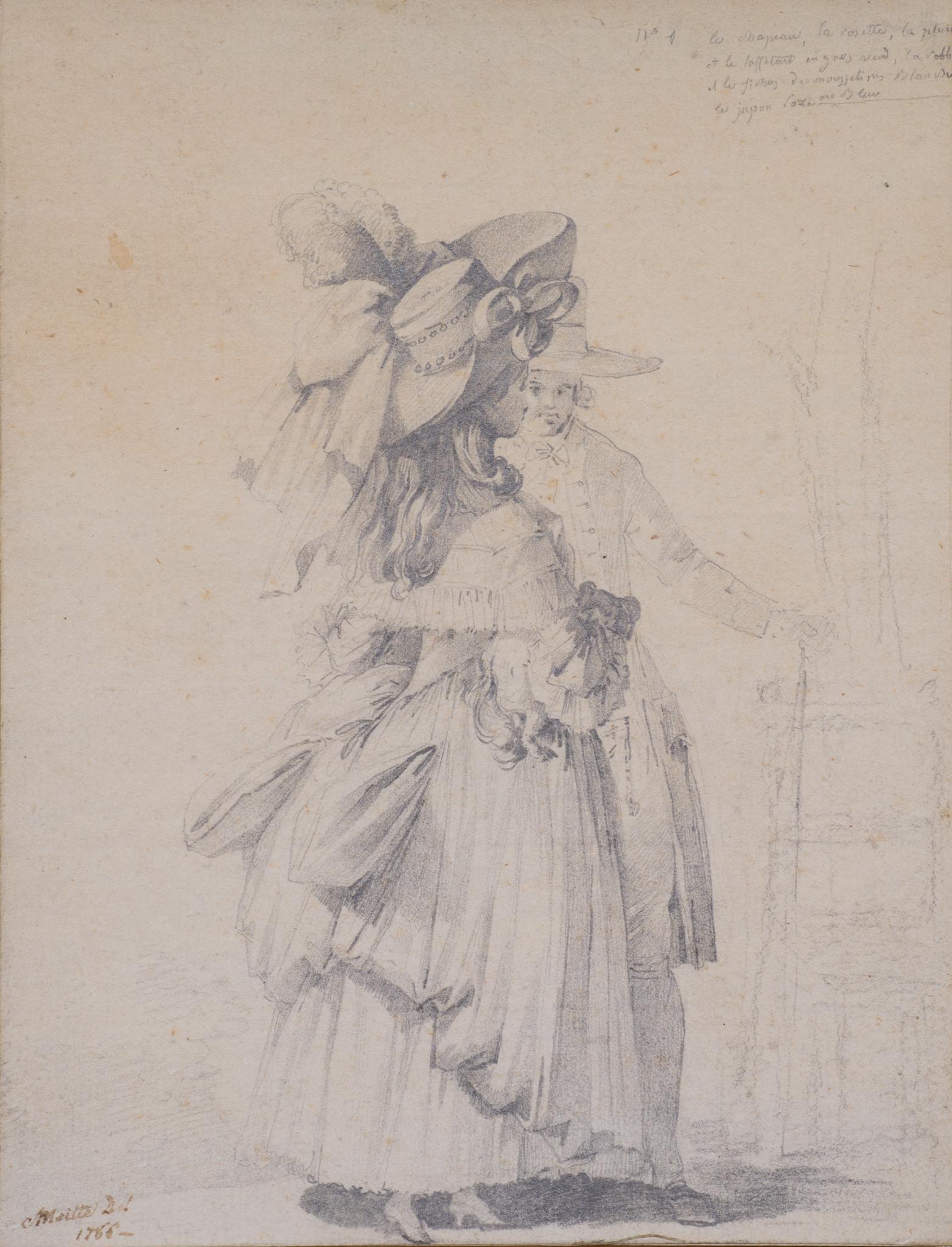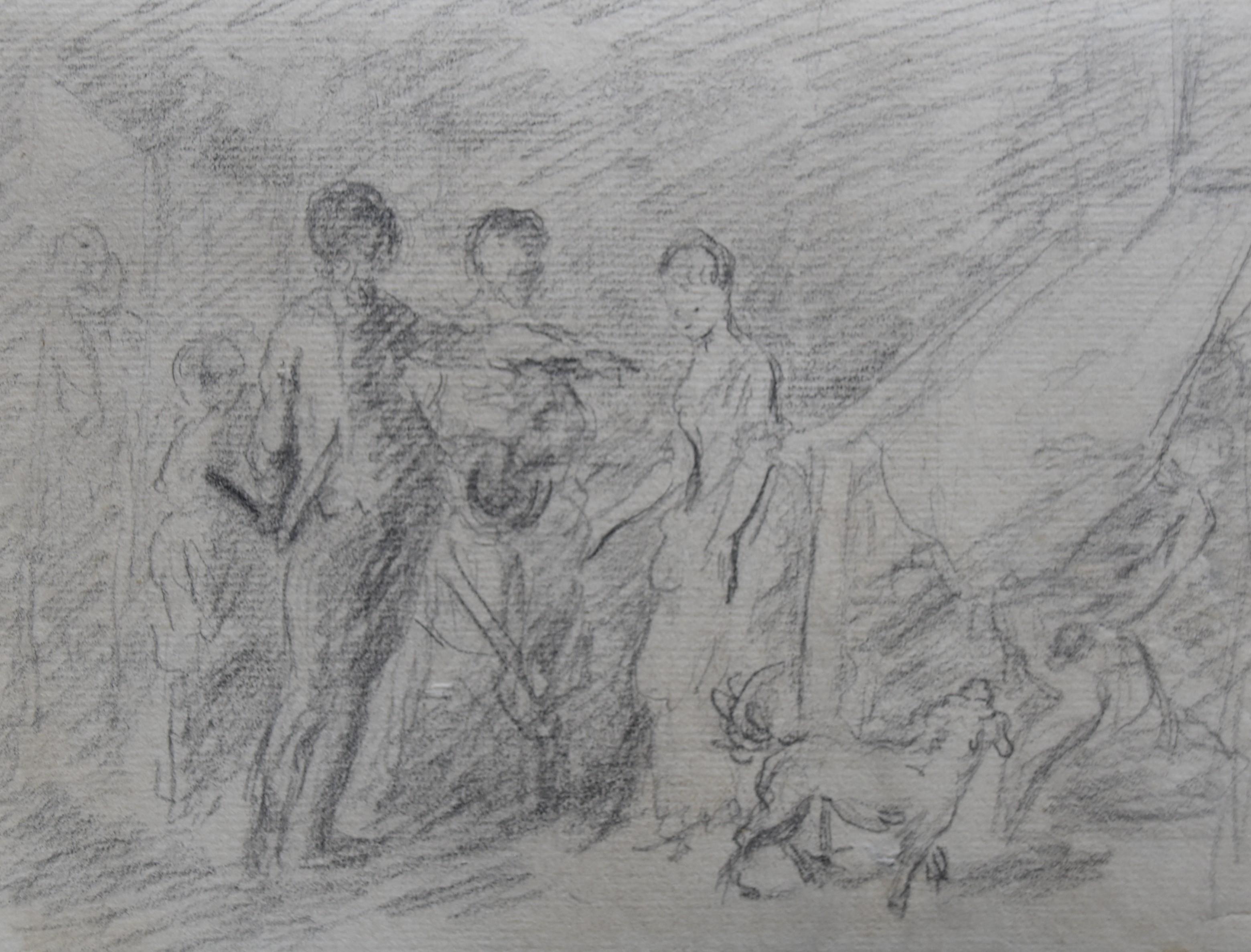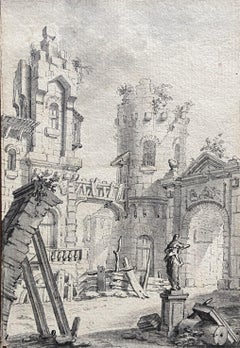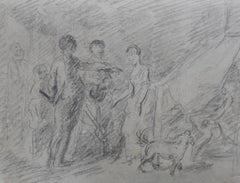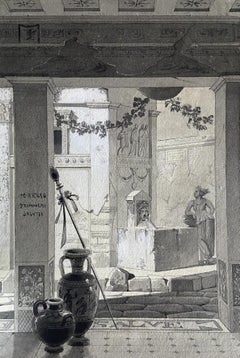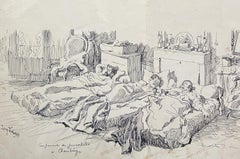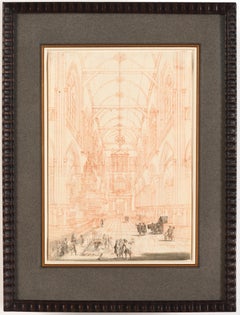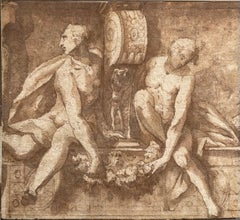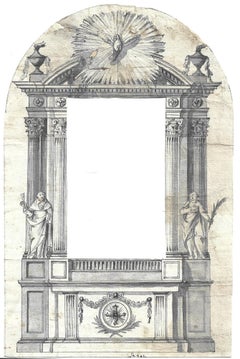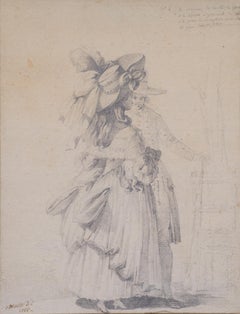Items Similar to 18th Century Roman School , A Palazzo with antiques, drawing
Video Loading
Want more images or videos?
Request additional images or videos from the seller
1 of 9
Unknown18th Century Roman School , A Palazzo with antiques, drawingcirca 1750
circa 1750
About the Item
18th Century Roman School
A Palazzo with antiques
Brown ink and pen, brown ink wash on paper
12.5 x 20 cm
Framed : 28,5 x 35.5
This nice drawing represents a genre scene, with a nobleman, priests, a mother and her children in the middle of ancient sculptures, all in a Roman palazzo setting.
One can easily recognise the large sculptures, the Nile in the foreground, but also the Laocoon in the background on the right and the Apollo of Belvedere on the left. They were already very famous at the time and were kept in the Vatican.
The architecture of the Palazzo may be reminiscent of the Courtyard of the Octagon, formerly known as the Courtyard of Statues, which housed the first set of classical antiquities in the papal collections. It was here that Pope Julius II della Rovere (1502-1513) displayed his extraordinary collection of ancient sculptures, which aimed to bring the Rome of the Caesars to life in the Rome of the Popes.
But the setting does not match exactly and it is more likely that this is an imaginary view in which the artist shows a remarkable sense of humour and fantasy.
- Creation Year:circa 1750
- Dimensions:Height: 4.93 in (12.5 cm)Width: 7.88 in (20 cm)
- Medium:
- Movement & Style:
- Period:
- Condition:
- Gallery Location:Paris, FR
- Reference Number:Seller: inv 5711stDibs: LU1112211219052
About the Seller
5.0
Platinum Seller
Premium sellers with a 4.7+ rating and 24-hour response times
Established in 2018
1stDibs seller since 2019
246 sales on 1stDibs
Typical response time: <1 hour
- ShippingRetrieving quote...Shipping from: Paris, France
- Return Policy
Authenticity Guarantee
In the unlikely event there’s an issue with an item’s authenticity, contact us within 1 year for a full refund. DetailsMoney-Back Guarantee
If your item is not as described, is damaged in transit, or does not arrive, contact us within 7 days for a full refund. Details24-Hour Cancellation
You have a 24-hour grace period in which to reconsider your purchase, with no questions asked.Vetted Professional Sellers
Our world-class sellers must adhere to strict standards for service and quality, maintaining the integrity of our listings.Price-Match Guarantee
If you find that a seller listed the same item for a lower price elsewhere, we’ll match it.Trusted Global Delivery
Our best-in-class carrier network provides specialized shipping options worldwide, including custom delivery.More From This Seller
View All18th Century School, Courtyard of a palazzo, Architectural Capriccio, drawing
Located in Paris, FR
18th Century french School,
Courtyard of a ruined palazzo, An Architectural Capriccio,
Pen and black ink and black ink wash on paper
17 x 12 cm
In good condition
Framed : 32 x 26 c...
Category
1780s Old Masters Interior Drawings and Watercolors
Materials
Ink
France 18th Century, The Surprised Lovers, original drawing
Located in Paris, FR
France circa 1770
Two lovers surprised in bed
Black chalk on paper
13 x 17 cm
Modern frame : 34 x 38 cm
This drawing had been attributed to Gabriel de Saint Aubin (1724-1780). It's...
Category
1760s Old Masters Interior Drawings and Watercolors
Materials
Chalk
French Romantic School, View of a roman atrium, drawing
Located in Paris, FR
French Romantic school circa 1850
An antique Roman Atrium
signed lower right (illegible)
Ink, Ink wash and white gouache heightenings
20 x 13 cm
Framed : 35.5 x 27 cm
The signatu...
Category
1850s Romantic Interior Drawings and Watercolors
Materials
Ink
Louis Tinayre (1861-1942) An encampment of journalists, signed drawing
Located in Paris, FR
Louis Tinayre (1861-1942)
An encampment of journalists in Chambéry,
signed and titled lower left "Campement de journalistes à Chambéry"
Ink on paper
In quite good condition, a a visible vertical fold in the centre, some stains and foxings
21 x 29 cm
Framed : 33.7 x 45.5 cm
Louis Tinayre's background and adventurous life obviously inform this humorous and detailed scene. He demonstrates a remarkable sense of observation, capturing this scene of extraordinary life like a journalistic illustrator.
A contributor, to whom I'd like to express my sincere thanks, sheds important light on the nature of this scene.
It appears that this drawing is the draft for an illustration published in “Le Monde illustré” of August 4, 1888 (page 77), to accompany the article “Épilogue du voyage présidentiel” (Epilogue to the presidential trip) - president Sadi Carnot- en Savoie et en Dauphiné (p. 74), which ends with: “As a picturesque note, we enclose an improvised journalists' dormitory in Chambéry, where our colleagues deeply regretted the comfort of the special train”.
As a quasi-ethnographic observer, Tinayre's interest lies in the journalists' camp, which he turns into a tender, comical scene. We understand him better when we know that he may have been similarly fascinated by the territories of Madagascar, the North Pole or the Far West that he painted and drew.
Louis Tinayre was born on 14 March 1861 in Neuilly-sur-Seine. His mother, Victoire Tinayre, was a teacher and a member of the International Workers' Association.
Louis was the son of a Communard couple. His father, Jean Joseph, known as Jules Tinayre (Issoire 1821 - Paris 1871) was shot during the Bloody Week. His mother, Victoire Tinayre, fled with her children. Louis was the first to be sent to Hungary, and the rest of the family (including his brother Julien) joined him there later. He studied Fine Arts at the Hungarian University of Fine Arts in Budapest.
Returning to Paris in 1880 (after the amnesty), Louis Tinayre assiduously frequented Le Chat noir, where he met the positivists and Adèle Jacomet (Buenos Aires 1867-1946), whom he married in 1888.
He became an animal painter and press illustrator and was sent by Le Monde Illustré to cover the second expedition to Madagascar (then under French protectorate) in 1895.
He stayed there, fascinated, for six months and produced numerous drawings and photographs. Back in France, he created eight 5 x 4 meters dioramas presented at the National and Colonial Exhibition in Rouen in 1896.
He returned to Madagascar in 1898 to prepare the creation of a giant panorama representing the surrender of Antananarivo in 1895. The Malagasy pavilion at the 1900 Universal Exhibition in Paris allowed him to admire the dioramas (on the ground floor) and the panorama (on the first floor).
On his second trip, Tinayre took a Lumière cinematograph with him to document the daily life of the Malagasy people, no doubt to facilitate the design of the vast panorama. These short films were donated to the Cinémathèque française in 2009 by his grandson, Alain Tinayre.
One of the admirers of Tinayre's drawings, watercolours, paintings and photographs at the Universal Exhibition was Prince Albert I of Monaco: from 1901 onwards, Tinayre accompanied him on his hunts, painting scenes in North Africa, Russia, the Far West (Wyoming) and the North Pole. Tinayre, the official painter of the Prince's scientific expeditions, left his name to a glacier.
Together with the painter Alexandre Jean-Baptiste Brun, he painted the four murals in the large amphitheatre of the Oceanographic Institute in Paris. Louis Tinayre painted the figures while Alexandre Brun...
Category
1890s Realist Interior Drawings and Watercolors
Materials
Ink
Episode of the Franco-Prussian war of 1870, a cantonment of soldiers, drawing
Located in Paris, FR
French School 19th Century
Episode of the Franco-Prussian war of 1870, a cantonment of soldiers during the siege of Paris
Pen and brown ink on paper
15 x 23 cm
Annotated on the lower...
Category
1870s Realist Interior Drawings and Watercolors
Materials
Ink
L V Guirand de Scevola (1871-1950) A Man writing at his desk , Signed pastel
By Lucien-Victor Guirand de Scévola
Located in Paris, FR
Lucien-Victor Guirand de Scevola (1871-1950)
A Man writing at his desk, 18th century interior scene
Pastel on paper
Signed upper right
20.5 x 15.8 cm
Framed under glass : 37 x 31.5 cm
It is known that Guirand de Scevola was very interested in the Palace of Versailles and its Old Regime atmosphere, that he often painted it and that he participated in the Versailles Revival movement at the beginning of the century. This probably led him to paint scenes in the 18th century style, for which he was particularly well known and which are still sought after.
What is striking is the modernity of the execution of our pastel, which obviously contrasts with its subject in the style of the 18th century. Guirand de Scevoal is a great colourist and he proves it here with eclat, by building up his composition with white pastel highlights, contrasting with brown and black. There is something of the northern painters in this treatment of light. All this, as always with him, is very subtle. The light radiating from the window is almost an abstract notation, but it gives meaning to this interior scene.
Lucien-Victor Guirand de Scévola ( 1871 – 1950) was a French painter.
He was student of Fernand Cormon and Pierre Dupuis...
Category
1920s Art Deco Interior Drawings and Watercolors
Materials
Pastel
You May Also Like
Interior of the Nieuwe Kerk, Amsterdam
Located in Paris, Île-de-France
Jan Goeree (Middelburg 1670 – Amsterdam 1731)
Interior of the Nieuwe Kerk, Amsterdam (c. 1724)
Red chalk for the architecture, pen and black ink, grey wash on paper
Composition reversed in preparation for engraving
25 × 17.5 cm
Watermark: Hunting horn, Churchill 318 (dated 1724)
Provenance
Private collection, France
Context & Attribution
Trained in the studio of Gérard de Lairesse, Jan Goeree was among the finest Dutch engravers of the early eighteenth century, celebrated for his architectural views of Amsterdam. This drawing is a preparatory study for an engraving of the same subject now preserved in a major public collection. The final print—slightly larger—closely follows the reversed composition of this sheet.
Subject
In the center of the Gothic nave, five bearers carry a catafalque toward a freshly dug grave—a tribute to the naval heroes often buried in the Nieuwe Kerk. This funerary motif, familiar from Dutch painting (e.g. Emanuel de Witte, 1657), evokes the vanitas theme and the transience of earthly life.
Technical Analysis
Goeree’s use of red chalk for the architecture and ink for the figures reveals his working method: the chalk lines could be used to produce a counterproof restoring the correct orientation of the architecture, while the inked figures remained adjustable before the design was transferred to the copper plate.
Place within the Oeuvre
Drawings of church...
Category
Early 18th Century Old Masters Interior Drawings and Watercolors
Materials
Chalk, Ink
Study for a fresco
Located in Paris, Île-de-France
Attributed to Francesco PENNI (1488 – 1528)
Study for a fresco
Pen and brown ink, brown wash heightened with white on prepared paper
14 x 12 cm
On the mount, handwriting inscriptio...
Category
16th Century Old Masters Interior Drawings and Watercolors
Materials
Ink
$11,631
Design for a large wooden confessional from the Fantoni Workshop
Located in Middletown, NY
A beautiful 17th century design for a confessional from the most important woodshop in Bergamo.
Pen and grayish black ink on cream laid paper, 11 1/8 x 7 1/4 inches (283 x 185 mm), ...
Category
Mid-20th Century Old Masters Interior Drawings and Watercolors
Materials
Laid Paper, Ink
Rare on the Art Market, A Drawing by Moitte, A Fashionable Couple, 1766
Located in Stockholm, SE
Pierre Etienne Moitte studied in Paris under Jacques-Firmin Beauvarlet and Pierre-François Beaumont (1719–1769). In 1771, he was accepted (agréé) by the Académie Royale de Peinture e...
Category
1760s Old Masters Figurative Drawings and Watercolors
Materials
Paper, Pencil
Convent interior
Located in Paris, IDF
Hippolyte Victor Valentin SEBRON
(Caudebec-en-Caux, 1801 – Paris, 1879)
Convent interior
Ink, pen and wash
Signed and dated lower left
27,5 x 20 cm
1839
Pupil of Daguerre from the age of 29, Sebron entered the Ecole des Beaux-Arts in Paris under the teaching of Cogniet. He exhibited regularly at the Paris Salon between 1831 and 1878.
First employed in the painting of dioramas, he then produced numerous paintings, particularly interiors of churches...
Category
Early 19th Century French School Interior Drawings and Watercolors
Materials
Ink, Pen
"Steel Factory" Cuban Mid 20th Century Modern Drawing WPA Latin Art Industrial
Located in New York, NY
"Steel Factory" Cuban Mid 20th Century Modern Drawing WPA Latin Art Industrial
Ink on paper. 12 x 19 inches. Pogolotti lived in Paris in the 1930s. The drawing here comes from the collection of his Parisian ophthalmologist, Dr. Prokopenko . Unfortunately, the artist lost his eyesight in 1938.
Marcelo Pogolotti (1902–1988) was a Cuban painter...
Category
1930s Modern Figurative Drawings and Watercolors
Materials
Paper, Ink
Recently Viewed
View AllMore Ways To Browse
Large Architectural Drawing
Framed Architectural Drawings
Antique Architectural Drawings
Set Architectural Drawings
Antique Drawing Set
Roman School
Old Master Drawings Framed
Architectural Drawings Of Interiors
18th Century Pen
18th Century Pen And Ink
Master Apollo
Julius Caesar Sculpture
Apollo Belvedere Sculpture
Antique Paintings Of Apollo
Julius Caesar Painting
Joe Giuffrida
Royce Thyberg Gordon
Vincent Dubois
